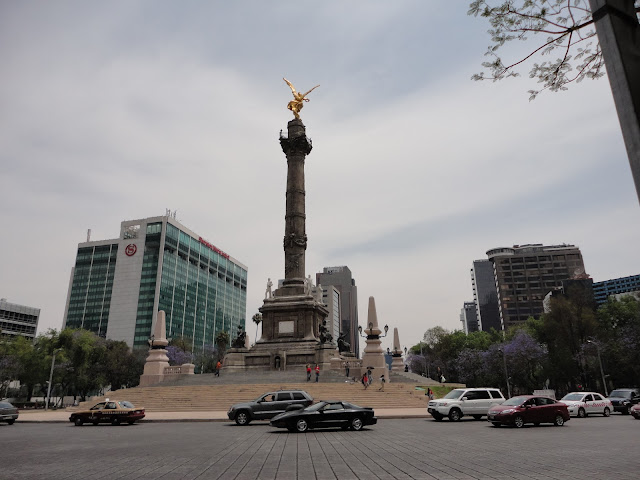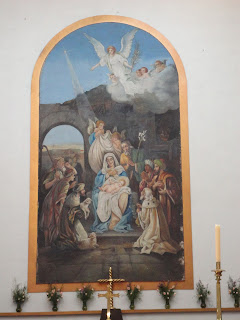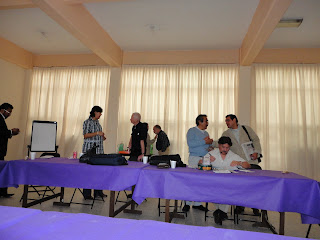Of course, I knew that they would be. Here are some highlights of the last couple of days:
Yesterday (Tuesday) I decided that since I had been in the city for a whole week and worked every day without a break, I should try to take some time for myself. So I took the metro (which is incredibly cheap at 3 pesos -- the equivalent of about 24 cents) to the Centro Histórico. The Zócalo is the main square or plaza of the old city, and the major landmark there is the Catedral Metropolitana
.
This is the main entrance to the cathedral, which is enormous. Because Mexico City is built on a dry lakebed, the building has shifted over the years -- floors are uneven, for example. The style is baroque, with lavish ornamentation and embellishment. Here, for example, is the retablo, or the main altar.
Because flash photography is not allowed I really was not able to take the quality of pictures I had hoped for, but this does give something of the scale. This is all carved cedar painted with 24 karat gold. Here you can see some of the detail:
Every square inch of the surface, it seems, is covered with decoration: leaves, flowers, vines, clusters of grapes, angels, shells... It's pretty overwhelming not only because of the elaboration, but also the sheer size. Plus the volume -- there are five side chapels on each outer aisle plus the main altar is flanked by two side altars. And all of them are elaborately decorated and carved. One other aspect of these altar pieces is that each has embedded within it paintings of various saints or scenes from the life of Christ.
Here, for example, is the portrait of my patron, St. Francis of Assisi:

Upon exiting the cathedral, I got in line to visit the Templo Mayor. This is one of the reasons why I say "Things are different here." This is an archeological site just beyond the zócalo, where the major pyramids of the ancient Aztecs were located. After the Spaniards came and conquered the local indigeneous tribes, of which the Aztec were only one, they essentially destroyed the important religious and cultural sites of their predecessors. Of course they weren't able to destroy them utterly, and about thirty years ago when the city of Mexico started some public works project or other, they discovered the ruins. Thousands of years of ruins -- something like seven layers had been constructed one on top of another, each more grand in size and scale than the previous. So right next to the major downtown square in the historic center is this enormous archeological dig -- scholars, students, educators, scientists are all gathered doing their work while tourists (like me) peer down from catwalks above the site.
This gives some idea of what it looks like:
What I found different about all this is that Mexicans, by and large, are very knowledgeable about and very proud of the indigenous people and their heritage. In the US, we know little about the history of our country before the Europeans settled and colonized. Here there are many streets, neighborhoods, schools, etc. named for the indigenous heroes -- case in point -- the downtown neighborhood known as Cuautémoc. I'm sure that part of the pride that these people feel is that so many are of mixed race, both European and indigenous blood.
After the tour of the archeological site I entered the museum, which was an enormous and very thorough display of the cultural artifacts of the indegenous peoples of this central area of Mexico. It was quite a long day. When I finally left, I found a lunch place a few blocks away in Mexico City's Chinatown. The food was, frankly, awful. I won't be back. (I should have known better.)
Then after more walking around, I went into the local
Sears. Things are different here ... Sears is very upscale in Mexico, and considered a very expensive department store. It is definately NOT a store for the ordinary person the way Sears is in the US. Pricey clothing, perfume, jewelry, furniture. It was different.
One of my main adventures was taking a bus back to the neighborhood where the Church is located. I was really pleased that my Spanish was good enough to ask questions about which bus, where, how much, etc.
I thought that was the end of my day (and you thought that was the end of this long blog post) but when I got back to the apartment in the church office building, the sexton, Missué, was waiting to talk to me. Things are different here. She wanted to be sure that I knew that the ambassadors would be here in the morning, and that I should make an effort to introduce myself to them and make myself known to the internation community.
Honestly, I thought maybe I was having a language problem, not understanding exactly what she was saying. The conversation went something like this...
Frank: "How many of them will there be?"
Missué: "Oh, thirty or forty."
Frank "Thirty or Forty!"
Missué: "Yes, they meet here occasionally because this is a central location. Then they take a bust together to the meeting place. We have coffee for them so they can socialize."
I didn't remember this part in the job description, but sure enough this morning I met about thirty or forty ambassadors. Honestly, I was thinking of it as a kind of evangelistic project -- maybe I would meet an English speaking ambassador who was an Anglican. And sure enough, I did. Delrose Montague, Ambassador from Jamaica, is a very elegant and gracious lady and also an Anglican, and inquired about services. Maybe we'll see her here here for Holy Week or Easter.
I also met ambassadors from Belize (who knew Bishop Sylvestre Romero), Austria (who was most interested in the fact that I had studied in Vienna for a summer course while I was a college student) and Dominican Republic (who had been educated at an Episcopal School in the DR and knew many Episcopal clergy there!) I also made the acquaintance of ambassadors from Brazil, Peru, Costa Rica, Guatemala, Hungary, Romania, Greece, Korea, Iraq, Pakistan, Iraq, Morrocco, and many others as well as representatives from the UN and the OAS.
Things are different here...






































